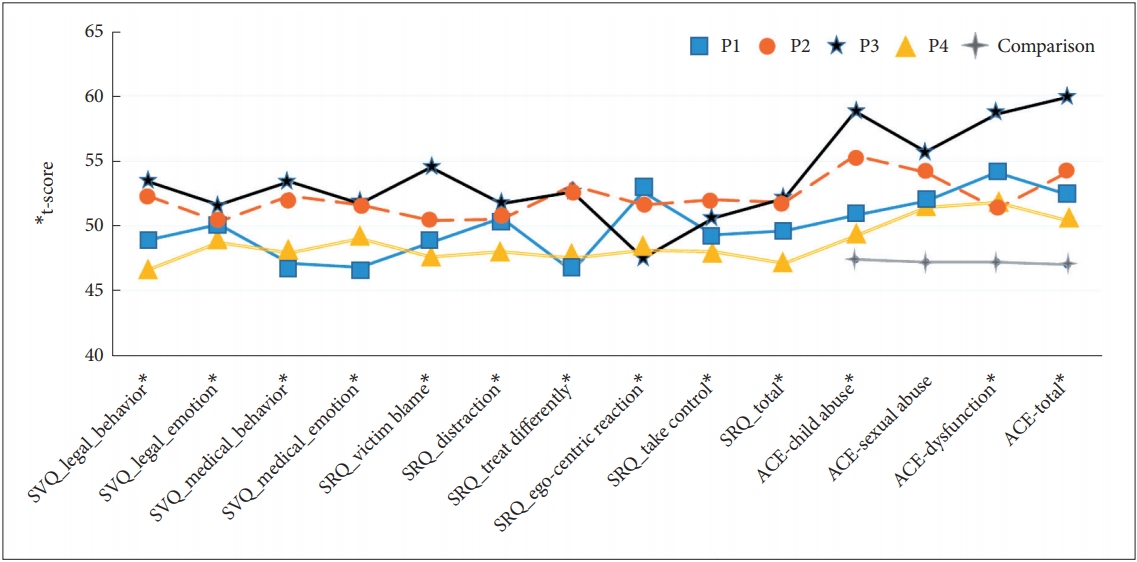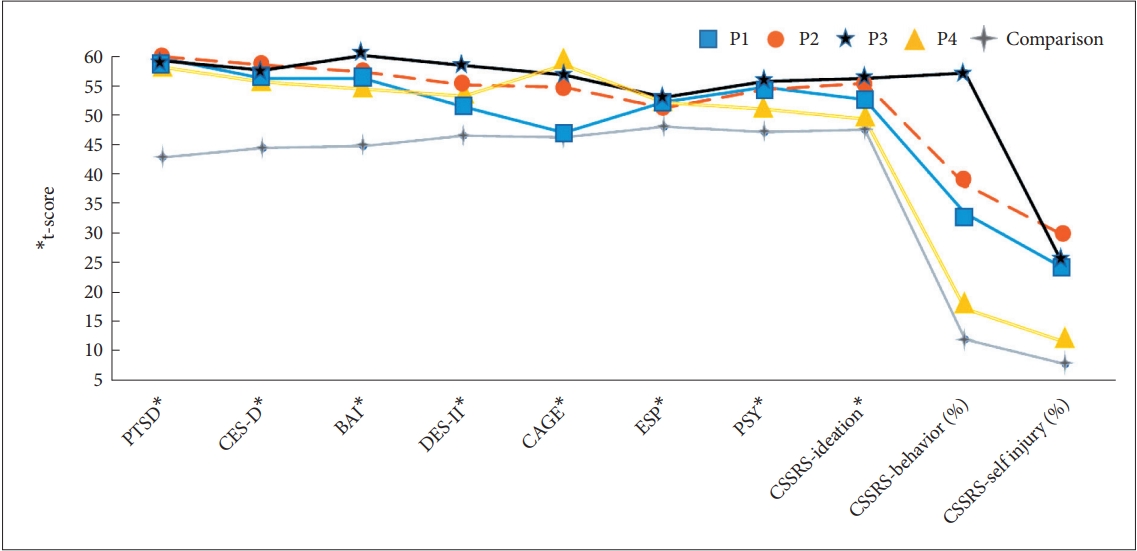1. Smith SG, Zhang X, Basile KC, Merrick MT, Wang J, Kresnow MJ, et al. The National Intimate Partner and Sexual Violence Survey: 2015 Data Brief-Updated Release. Atlanta: National Center for Injury Prevention and Control Centers for Disease Control and Prevention; 2018.
2. Ministry of Gender Equality and Family of South Korea. The Final Report of 2016 Korean National Incidence Study. Seoul: Ministry of Gender Equality and Family of South Korea; 2016.
4. Fischer S, Stojek M, Hartzell E. Effects of multiple forms of childhood abuse and adult sexual assault on current eating disorder symptoms. Eat Behav 2010;11:190-192.


5. Mason F, Lodrick Z. Psychological consequences of sexual assault. Best Pract Res Clin Obstet Gynaecol 2013;27:27-37.


8. Davidson JR, Hughes DC, George LK, Blazer DG. The association of sexual assault and attempted suicide within the community. Arch Gen Psychiatry 1996;53:550-555.


9. Kim YS, Kim SJ, Kong BG, Kang JW, Moon JJ, Jeon DW, et al. Psychiatric symptoms among female adult victims of sexual molestation: comparison with rape victims. Korean J Psychosom Med 2016;24:208-216.
10. Kim SH, Choi JY. The effect of post-traumatic cognition on the psychological sequelae of sexual violence in women. Health Soc Welfare Rev 2018;38:188-216.

12. Peter-Hagene LC, Ullman SE. Sexual assault-characteristics effects on PTSD and psychosocial mediators: A cluster-analysis approach to sexual assault types. Psychol Trauma 2015;7:162-170.


13. Choi JH, Kim K, Kim JY. Profile of sexual assault experiences among the adult female: Analysis of the Nationwide Survey of Sexual Assault in Korea. Korean J Soc Welfare Stud 2019;50:271-296.
16. Kim KH, Kim JW, Park HY, Ryou B. Profile of sexual violence experiences among the survivors using victim support services in Korea. Korean J Soc Welfare Stud 2016;47:255-280.

17. Jones JS, Rossman L, Wynn BN, Dunnuck C, Schwartz N. Comparative analysis of adult versus adolescent sexual assault: epidemiology and patterns of anogenital injury. Acad Emerg Med 2003;10:872-877.


18. Spohn CC. A comparison of sexual assault cases with child and adult victims. J Child Sex Abus 1995;3:59-78.

19. McCrae JS, Chapman MV, Christ SL. Profile of children investigated for sexual abuse: Association with psychopathology symptoms and services. Am J Orthopsychiatry 2006;76:468-481.


20. Campbell R, Raja S. The sexual assault and secondary victimization of female veterans: help-seeking experiences with military and civilian social systems. Psychol Women Q 2005;29:97-106.

21. Ullman SE. Psychometric characteristics of the Social Reactions Questionnaire: a measure of reactions to sexual assault victims. Psychol Women Q 2000;24:257-271.

22. Ullman SE. Relationship to perpetrator, disclosure, social reactions, and PTSD symptoms in child sexual abuse survivors. J Child Sex Abus 2007;16:19-36.

23. Ullman SE, Filipas HH, Townsend SM, Starzynski LL. The role of victim-offender relationship in womenŌĆÖs sexual assault experiences. J Interpers Violence 2006;21:798-819.


24. Campbell R, Dworkin E, Cabral G. An ecological model of the impact of sexual assault on womenŌĆÖs mental health. Trauma Violence Abuse 2009;10:225-246.


26. Filipas HH, Ullman SE. Child sexual abuse, coping responses, selfblame, posttraumatic stress disorder, and adult sexual revictimization. J Interpers Violence 2006;21:652-672.


27. Ports KA, Ford DC, Merrick MT. Adverse childhood experiences and sexual victimization in adulthood. Child Abuse Negl 2016;51:313-322.


28. Kim KH, Ryou B, Kim JW. A Study of Development and Application on Korean Sexual Assault Case Record Abstraction Instrument (KSACRAI). Korean J Vict 2019;27:213-244.

29. Kim K, Mennen FE, Trickett PK. Patterns and correlates of coŌĆÉoccurrence among multiple types of child maltreatment. Child Fam Soc Work 2017;22:492-502.


30. Cicchetti D. Defining Child Maltreatment: The Interface between Policy and Research. In: Cicchetti D, Editor Child Abuse, Child Development, and Social Policy. Norwood, NJ: Ablex; 1993.
31. Sim KS, Ahn HN. A Validation of the Korean Version of the Social Reactions Questionnaire. Korean J Couns Psychother 2014;26:271-296.
32. Felitti VJ. The relationship of adult health status to childhood abuse and household dysfunction. Am J Prev Med 1998;14:245-258.

33. Dong M, Giles WH, Felitti VJ, Dube SR, Williams JE, Chapman DP, et al. Insights into causal pathways for ischemic heart disease: adverse childhood experiences study. Circulation 2004;110:1761-1766.


34. Edwards VJ, Holden GW, Felitti VJ, Anda RF. Relationship between multiple forms of childhood maltreatment and adult mental health in community respondents: results from the adverse childhood experiences study. Am J Psychiatry 2003;160:1453-1460.


35. Hughes K, Bellis MA, Hardcastle KA, Sethi D, Butchart A, Mikton C, et al. The effect of multiple adverse childhood experiences on health: a systematic review and meta-analysis. Lancet Public Health 2017;2:e356-e366.


36. Felitti V, Anda R. The Relationship of Adverse Childhood Experiences to Adult Medical Disease, Psychiatric Disorders and Sexual Behavior: Implications for Healthcare. In: Lanius R, Vermetten E, Pain C, editor. The Impact of Early Life Trauma on Health and Disease: The Hidden Epidemic. Cambridge: Cambridge University, 2010, p. 77-87.
37. Foa EB, McLean CP, Zang Y, Zhong J, Powers MB, Kauffman BY, et al. Psychometric properties of the Posttraumatic Diagnostic Scale for DSM-5 (PDS-5). Psychol Assess 2016;28:1166-1171.


38. Radloff LS. The CES-D scale: a self-report depression scale for research in the general population. Appl Psychol Meas 1977;1:385-401.
39. Chon KK, Choi SC, Yang BC. Integrated Adaptation CES-D in Korea. Korean J Psychol Health 2001;6:59-76.
40. Weissman MM, Sholomskas D, Pottenger M, Prusoff BA, Locke BZ. Assessing depressive symptoms in five psychiatric populations: a validation study. Am J Epidemiol 1977;106:203-214.


41. Beck AT, Epstein N, Brown G, Steer RA. An inventory for measuring clinical anxiety: psychometric properties. J Consult Clin Psychol 1988;56:893-897.


42. Beck AT, Steer RA. Relationship between the Beck anxiety inventory and the Hamilton anxiety rating scale with anxious outpatients. J Anxiety Disord 1991;5:213-223.

43. Kwon SM. Assessment of psychopathology in anxiety disorder. Korean J Physiol Pharmacol 1997;6:37-51.
44. Carlson EB, Putnam FW. An update on the dissociative experiences scale. Dissociation Progress Dissociative Disorder 1993;6:16-27.
45. Kim D, Im H, Roh S. Factor structure of Korean dissociative experience scale (KDES-II) among psychiatric patients. J Korean Neuropsychiatr Assoc 2007;46:136-143.
46. Ewing JA, Rouse BA. Identifying the hidden alcoholic. 29th International Congress on Alcohol and Drug Dependence. Sydney, Australia: 1970.
47. Dhalla S, Kopec JA. The CAGE questionnaire for alcohol misuse: a review of reliability and validity studies. Clin Invest Med 2007;30:33-41.


48. Harkness AR, McNulty JL, Ben-Porath YS. The Personality Psychopathology Five (PSY-5): Constructs and MMPI-2 scales. Psychol Assess 1995;7:104-114.

51. Interian A, Chesin M, Kline A, Miller R, St. Hill L, Latorre M, et al. Use of the Columbia-Suicide Severity Rating Scale (C-SSRS) to classify suicidal behaviors. Arch Suicide Res 2018;22:278-294.


52. Pai D, Woo JM, Son MH, Lee C. The reliability and validity of the Korean version of Columbia-Suicide Severity Rating Scale in alcohol dependent patients. Psychiatry Investig 2015;54:222-227.

53. Freund R, Littell R. SAS System for Regression. 3rd Edition. Cary, NC: SAS Inst; 2000.
54. Trickett PK, Noll JG, Reiffman A, Putnam FW. Variants of intrafamilial sexual abuse experience: Implications for short-and long-term development. Dev Psychopathol 2001;13:1001-1019.


55. Ahrens CE. Being silenced: the impact of negative social reactions on the disclosure of rape. Am J Community Psychol 2006;38:31-34.


56. Campbell R. The community response to rape: VictimsŌĆÖ experiences with the legal, medical, and mental health systems. Am J Community Psychol 1998;26:355-379.


57. Campbell R, Raja S. Secondary victimization of rape victims: insights from mental health professionals who treat survivors of violence. Violence Vict 1999;14:261-275.


58. Elklit A, Christiansen DM. Risk factors for posttraumatic stress disorder in female help-seeking victims of sexual assault. Violence Vict 2013;28:552-568.













